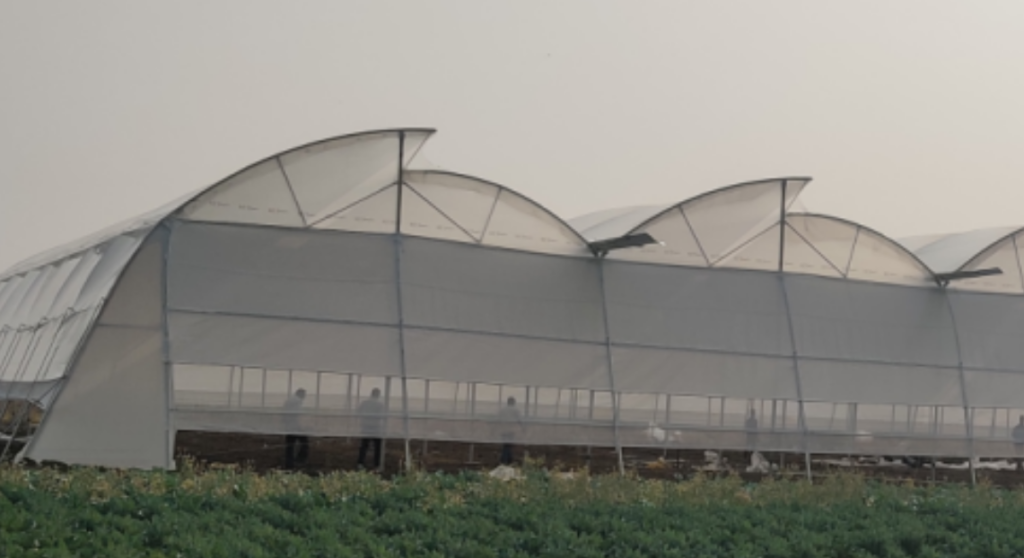Embracing Sustainable Growth: A Comprehensive Guide to Greenhouse Farming
Introduction:
Welcome to Varad Hightech Agricultural Pvt. Ltd. a leading greenhouse construction company, committed to revolutionizing modern agricultural practices. In this blog, we will delve into the fascinating world of greenhouse farming, exploring its numerous advantages, efficient cultivation techniques, and the environmental benefits it offers. Whether you are a seasoned farmer or a curious individual seeking information, this guide aims to provide valuable insights into the art of greenhouse farming.

Understanding Greenhouse Farming: Greenhouse farming, also known as controlled environment agriculture, involves the cultivation of crops within a covered structure equipped with technologies that regulate temperature, humidity, light, and other environmental factors. Unlike traditional open-field farming, greenhouse farming offers numerous benefits such as extended growing seasons, optimal crop yields, and reduced dependency on weather conditions. This method allows farmers to experiment with a wide range of crops, including vegetables, flowers, and even exotic fruits, thereby maximizing their profitability.
Advantages of Greenhouse Farming
1. Crop Protection: Greenhouses act as a shield against pests, diseases, and adverse weather conditions, safeguarding crops from external threats and creating a controlled environment conducive to their growth.
2. Year-Round Production: With superior control over environmental factors, greenhouse farming facilitates year-round cultivation, enabling farmers to meet market demands consistently.
3. Increased Crop Yields: By manipulating growing conditions optimally, greenhouse farming boosts crop productivity, resulting in increased yields and financial gain for farmers.

4. Water Conservation: Greenhouses employ efficient irrigation systems that minimize water consumption, ensuring judicious usage and reducing the environmental impact.
5. Resource Optimization: Utilizing the advanced technology, greenhouse farming minimizes resource wastage by efficiently managing water, fertilizers, and energy consumption. This sustainable approach contributes to a greener and more eco-friendly world.
Essential Elements for Greenhouse Construction
To ensure an effective and productive greenhouse, certain critical elements must be considered during the construction phase. These elements include:
1. Choosing Right Location: The location of the greenhouse is crucial for its success. It should be placed in an area that receives maximum sunlight, away from trees or buildings that may shade the structure. Additionally, factors such as wind direction, drainage, and accessibility should be taken into account.
2. Design: The design of the greenhouse should be chosen based on its intended use and the climate of the area. Factors such as shape, size, materials, and ventilation options should be carefully considered to optimize light transmission and airflow while providing structural stability.
3. Foundation: A solid and well-constructed foundation is essential for the stability and longevity of the greenhouse. It should be able to support the weight of the structure, equipment, and plants while providing adequate drainage to avoid waterlogging.
4. Framing and Glazing: The framing of the greenhouse should be made from a durable and weather-resistant material such as aluminum or galvanized steel. The choice of glazing material, such as glass or polycarbonate, should be based on factors such as insulation properties, light transmission, and cost-effectiveness.

5. Ventilation: Good ventilation is necessary to regulate temperature, humidity, and air quality inside the greenhouse. This can be achieved through options such as sidewall vents, roof vents, or exhaust fans.
6. Insulation: To maintain a stable and optimal growing environment, proper insulation is crucial. Insulating materials such as double-layered glazing, thermal curtains, or insulation panels can help reduce heat loss during colder months and excessive heat buildup during hotter months.
7. Environmental Controls: Installing appropriate environmental control systems, such as heating, cooling, and irrigation systems, is essential for maintaining ideal growing conditions. These systems should be automated and capable of adjusting environmental factors like temperature, humidity, and watering based on pre-set parameters or feedback from sensors.
8. Lighting: In regions with limited sunlight or for specific plant requirements, adding supplemental lighting systems is necessary. LED grow lights are commonly used due to their energy efficiency and the ability to provide the necessary spectrum for plant growth.
